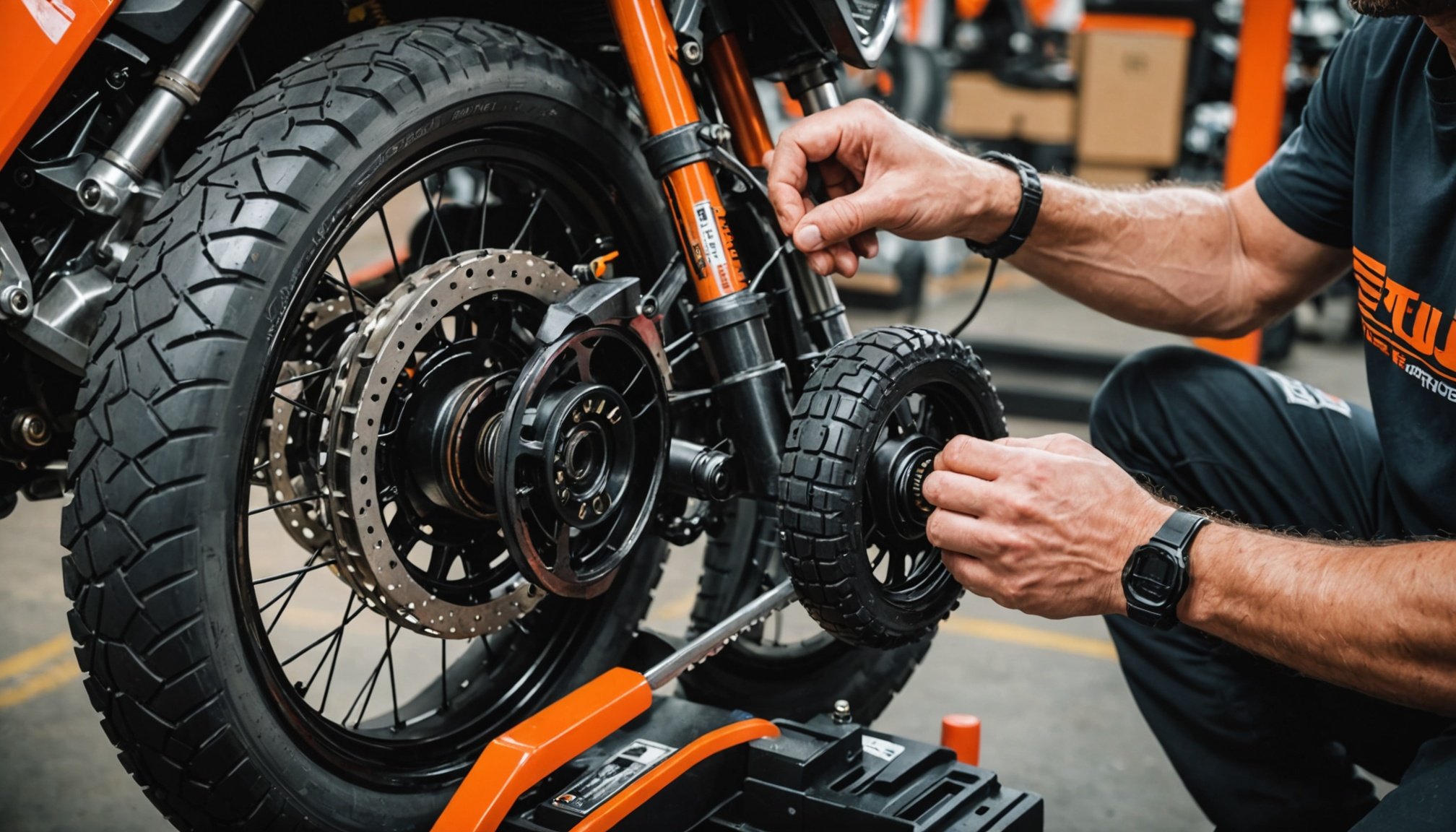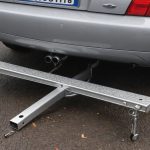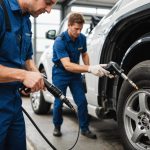The Ultimate Guide to Tubeless Tire Puncture Repair: Step-by-Step Strategies for Your KTM 790 Adventure
Why Tubeless Tires are a Must for Your Adventure Bike
When it comes to adventure biking, especially with a powerful machine like the KTM 790 Adventure, having the right tires can make all the difference. Tubeless tires have become increasingly popular among adventure bikers due to their superior puncture protection, lower tire pressure requirements, and overall performance both on and off the road.
“As someone who’s spent countless hours on the trails, I can attest that tubeless tires have been a game-changer,” says a seasoned adventure biker. “The ability to ride with lower pressures without the fear of a flat tire is invaluable, especially when navigating rough terrain.”
In parallel : Ultimate diy guide: transform your yamaha mt-07 with an aftermarket windscreen for superior wind protection
Understanding Tubeless Tires
Before diving into the repair process, it’s essential to understand how tubeless tires work. Unlike traditional tires that use an inner tube, tubeless tires rely on a special rim and tire design that creates an airtight seal. This seal is maintained by a layer of sealant inside the tire that can repair small punctures automatically.
“Tubeless tires provide better puncture protection because the sealant can often fix small punctures on the go,” explains a bike mechanic. “However, for larger punctures, you’ll need a repair kit.”
Also to see : Essential strategies for keeping your honda cb650f air intake spotless: a comprehensive guide
Essential Tools and Materials for Tubeless Tire Repair
To ensure you’re well-prepared for any puncture, here are the essential tools and materials you’ll need:
Tire Repair Kit
- Plugs
- Insertion tool
- Reaming tool
- Rubber cement (for some kits)
Additional Tools
- Pliers
- Tire pressure gauge
- Air compressor or pump
- Colby valve (in case you tear a valve stem)
- Extra tubeless tape (for rim preparation)
Sealant and Other Accessories
- Tubeless sealant (e.g., Muc-Off, Schwalbe, or Orange Seal)
- Sealant injector
- Valve stem and core
Step-by-Step Guide to Tubeless Tire Puncture Repair
Ensure Safety First
Move your bike to a safe, flat area if possible. If you’re on a trail, secure your bike and engage the parking brake. This step is crucial to avoid any further damage or risk.
Locate the Puncture
Inspect the tire for any visible punctures. If the puncture is not immediately visible, use soapy water to find the leak. Look for bubbles forming at the puncture site.
Remove the Object
Use pliers to carefully remove the object causing the puncture. Avoid enlarging the hole during this process.
Prepare the Hole
Insert the reaming tool into the puncture and work it back and forth to roughen the edges. This ensures the plug adheres securely.
Prepare the Plug
Thread a repair plug through the eye of the insertion tool. Then apply a small amount of rubber cement to the plug for better adhesion.
Insert the Plug
Push the insertion tool with the plug into the puncture. Leave about 1/2 inch of the plug sticking out of the tire. Remove the insertion tool with a twisting motion, leaving the plug in place.
Trim the Plug
Use pliers or scissors to trim the excess plug material flush with the tire surface.
Inflate the Tire
Use your air compressor or pump to inflate the tire to the recommended pressure. Check the pressure with your gauge to ensure accuracy.
Check for Leaks
Apply soapy water to the repaired area and look for bubbles, which would indicate a leak. If no bubbles appear, your repair is successful.
Common Issues and Solutions
Issues with Tubeless Tape
One of the most common issues with tubeless setups is the tape. If you find that your tire is not sealing properly, it’s often an issue with the tape.
“It is almost always an issue with the tape,” advises a bike enthusiast. “If you’ve just taped it and then punctured a hole for the valve, it might rip slightly. This can cause a small leak around the valve stem.”
To solve this, immediately pull the tape off and reapply it. Start with a tape that is slightly wider than the rim and ensure it starts up the edge of the rim but does not go beyond.
Essential Tips for a Successful Repair
Here are some essential tips to keep in mind when repairing your tubeless tires:
- Practice at Home: Before hitting the trails, practice using your repair kit on an old tire. It’s better to familiarize yourself with the process in a controlled setting.
- Carry a Portable Air Compressor: After repairing the tire, you’ll need to inflate it to the proper pressure. A portable air compressor is a perfect companion for your kit.
- Understand Limitations: Tire plugs are typically a temporary fix. Always have the damaged tire professionally repaired or replaced as soon as possible.
- Avoid Sidewall Repairs: Tire repair kits are designed for tread punctures only. If you experience sidewall damage, it’s time to swap to your spare.
- Pack for Specific Tires: If you’re running tubeless tires, consider kits that don’t require rubber cement for a quicker, more efficient repair.
Comparing Different Tire Repair Kits
When choosing a tire repair kit, it’s important to consider the specific needs of your bike and the type of riding you do. Here is a comparison of some popular kits:
| Kit | Tools Included | Price | Suitability |
|---|---|---|---|
| ARB Tire Repair Kit | Plugs, insertion tool, reaming tool, rubber cement | $50-$70 | Ideal for off-road and adventure bikes |
| Dynaplug Tire Repair Kit | Plugs, insertion tool, reaming tool | $40-$60 | Recommended for tubeless tires, known for reliability |
| Park Tools TB-2 Emergency Tire Boots | Tire boots, not plugs | $20-$30 | For cuts and larger punctures, not a replacement for plugs |
Real-World Examples and Anecdotes
One of the most compelling reasons to learn tubeless tire repair is the peace of mind it provides. Here’s an anecdote from an adventure biker:
“I was on a solo ride through the mountains when I hit a sharp rock and got a puncture. Thanks to my tubeless repair kit, I was able to fix the tire in under 30 minutes and continue my ride without any issues. It was a huge relief knowing I had the tools and knowledge to handle such a situation.”
Maintaining Your Tubeless Tires
To ensure your tubeless tires perform optimally, regular maintenance is crucial. Here are some tips:
Check Tire Pressure Regularly
Tubeless tires require lower pressures to work effectively. Consult a guide from manufacturers like SRAM or Enve to find the right pressure for your tires.
Reapply Sealant Periodically
The sealant inside your tires can dry out over time. Reapply sealant every few months or as recommended by the manufacturer.
Inspect the Rim and Tire
Regularly inspect the rim and tire for any signs of damage or wear. This can help prevent punctures and ensure a smooth ride.
Repairing tubeless tires on your KTM 790 Adventure is a skill that every adventure biker should master. With the right tools, knowledge, and practice, you can ensure that your rides are uninterrupted by punctures. Remember to always carry a spare tire and practice using your repair kit in a controlled environment.
“Tubeless tire repair is not rocket science, but it does require some practice and patience,” says a veteran biker. “Once you get the hang of it, you’ll be back on the road or trail in no time, ready for your next adventure.”
Share Your Experience
If you have any tips or stories about tubeless tire repair, feel free to share them in the comments below. Whether you’re riding a KTM Adventure, a Honda CRF Rally, or even a Royal Enfield, knowing how to repair your tubeless tires can make all the difference in your biking experience.
Share on Facebook | Tweet This | Read More About Adventure Bikes
By following this comprehensive guide, you’ll be well-equipped to handle any puncture that comes your way, ensuring that your adventures on your KTM 790 Adventure remain uninterrupted and enjoyable. Happy riding






